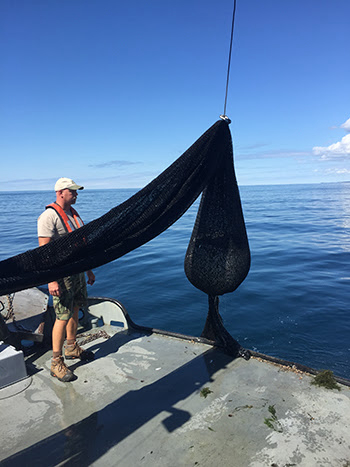Michigan: DNR Remote Control Sub to Study Lake Huron Fish Populations


DNR’s newest research vessel features unique technology to learn more about Lake Huron fish populations
Remotely operated vehicle (ROV) to be used on R/V Tanner
This month the Michigan Department of Natural Resources will begin assessing Lake Huron fisheries with the latest addition to its Great Lakes large vessel fleet – the R/V Tanner.
In addition to the standard complement of nets and trawls the DNR uses with its other research vessels, the R/V Tanner is equipped with some new and unique technology to help assess the status of fish populations and habitat in the second largest of the Great Lakes.
“The R/V Tanner is outfitted with state-of-the-art sampling technology, including a remotely operated vehicle that can carry a range of cameras and sensors, side-scan sonar and a scientific echosounder system,” said Todd Wills, DNR area research manager. “This equipment greatly expands our ability to assess the status of, and trends in, fisheries resources throughout Lake Huron so our fisheries biologists, and those of our partner agencies, have the best possible data to make management decisions.”
The remotely operated vehicle (ROV) is a small submarine operated from the R/V Tanner by a remote control. The ROV, which is equipped with lights and forward- and rear-facing cameras, is tethered to a cable and is rated for depths up to 1,000 feet. It has the ability to hold its cruising altitude at any depth, and can save images and video to a digital recorder housed on the vessel. In the future, it can be upgraded with a range of remote sensors.
“We will be examining how the ROV can help us determine the abundance of fish species, like the non-native round goby, that are a component of the rapidly changing Lake Huron food web but cannot be assessed with traditional sampling gear,” said David Fielder, DNR fisheries research biologist. “The camera system on the ROV is well-suited for these types of surveys. In addition, the ROV will provide a fish’s eye view of habitat that we have never been able to fully explore.”
Examining and mapping habitat on a larger scale is a job for which side-scan sonar is well-suited. The R/V Tanner is equipped with a fixed-mount side-scan sonar system in its onboard navigational electronics, and with a deployable torpedo-like device called a towfish that is pulled behind the vessel to generate a high-resolution picture of the lake bottom.
“Side-scan sonar emits pulses of sound that bounce off of underwater objects and are interpreted by a computer on the research vessel, which creates a very detailed, picture-like image of what is beneath and off to the sides of the boat. This imagery provides an excellent source of information on the composition and structure of the lake bottom, which is important for understanding where critical habitats for fish are located,” Wills said. “Knowing what is beneath our vessel also helps our captains keep sampling gear like trawls away from navigational and sampling hazards while under way.”
The R/V Tanner’s scientific echosounder also uses sound waves to assess habitat as well as fish abundance. Similar to how a traditional fish finder uses sound to “see” what is underneath an angler’s boat, a nearly 1-foot-diameter electronic device called a transducer emits pulses of sound beneath the hull of the R/V Tanner to determine water depth, bottom hardness and the abundance of fish species in its view. This information is recorded by a laptop computer on the vessel, and then processed and analyzed at a later time using specialized computer software.
“Having an understanding of the habitats where we deploy our traditional sampling gear, such as nets, can help us design surveys that do a better job of assessing fish populations,” said Ji He, DNR fisheries research biologist. “Data from the echosounder, when paired with our new mid-water trawl, can also help us determine the abundance of small prey fish and young game fish scattered throughout the water column, which is something we were unable to do before.”
For more information about the new technology aboard the R/V Tanner, contact Todd Wills at 586-465-4771, ext. 22.





